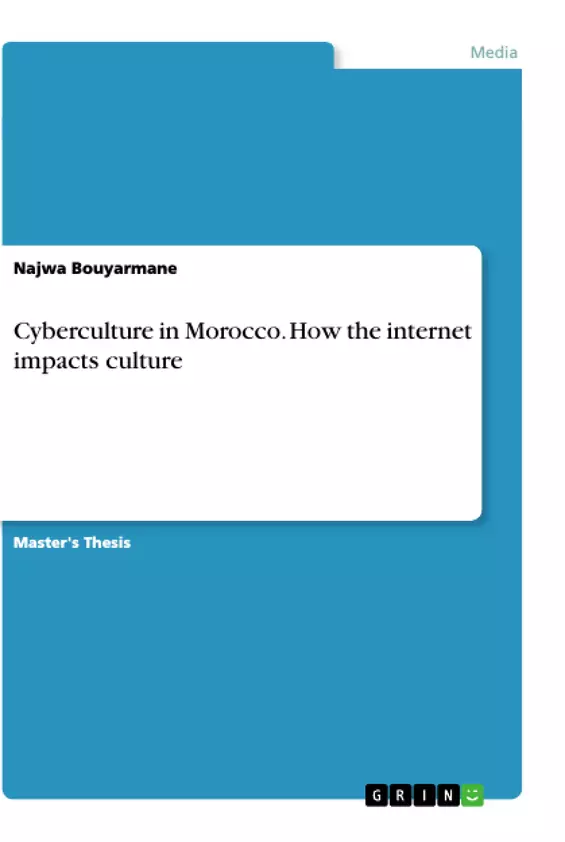The aim of this thesis is to study and analyse cyberculture on the Moroccan society, taking the city of Fez as a case study. Although Morocco is neither a developed nor an industrial country, Moroccan people are updated about new technologies, as this is obvious in the proliferation of cybercafés all over the country. Therefore, the aim of the thesis is to try to answer the following questions: Who are the people who go to cybercafés? Why do they go there? What are they looking for? If they come to talk, or in the Internet jargon “chat” are they aware to whom they are talking? Do they respect their online identities or do they create fake ones? What are the debates which are mostly raised there?
This thesis contains two major parts. The first part consists of a review of literature which relates what scientists, philosophers and other researchers have said about the emergence and issue of cyberculture in the world. The review of literature is approached in a critical way. It includes three chapters: popular cyberculture, cyberculture theories and cyberculture studies. The first chapter, popular cyberculture is concerned with the key words on which this research is based, such as: culture, cybercafé, cyberculture, cyberspace and the Internet. The second chapter deals with cyberculture theories, such as: the utopian theory and the virtual theory. Cyberculture studies dealt with in the third chapter includes: virtual communities, virtual identities, virtual bodies, MUDs (Multi-User Domains), features of the language of the cyberspace and gaming on-line, being the major activity online.
The second major part of the thesis deals with the data collection and data analysis. The tools used for the data collections are: the questionnaire, the participant and non-participant observation. These will be analysed and interpreted deeply in relation to cyberculture in the Moroccan context, and especially in Fez.
Inhaltsverzeichnis (Table of Contents)
- INTRODUCTION
- PART ONE: REVIEW OF THE LITERATURE
- Chapter I: Popular Cyberculture
- A – Terminology
- 1. Culture
- 2. Cybercafé
- 3. Cyberculture
- 4. Cyberspace
- 5. The Internet
- Chapter II - Cyberculture Theories
- A – Theories related to Cyberspace
- 1. The Utopian Theory
- 2. The Virtual Theory
- Chapter I: Popular Cyberculture
- A – Virtual Communities
- B – Virtual Identities
- C – Virtual Bodies
- D – MUDs
- E – Features of the Language of Cyberspace
- F – Gaming on-line: a Major Cyberspace Activity
- Chapter I: Methodology and Data Collection
- A – The Questionnaire
- B – The Respondents
- C – The Observation Scale
- 1. The Non-participant Observation
- 2. The Participant Observer Table
- Chapter II - Data analysis
- A – The Return Rate
- B – Data analysis of the questionnaire
- C – Data Analysis of the Observation
- 1. Non-participant Observation
- 2. Participant Observation
- 3. LambdaMOO : History and Map
- 4. LambdaMOO community’s Notice
- Chapter III - Implications and Suggestions
Zielsetzung und Themenschwerpunkte (Objectives and Key Themes)
This thesis explores cyberculture within Moroccan society, using the city of Fez as a case study. It investigates the rise of cybercafés in Morocco, analyzing user demographics, motivations for Internet access, and how individuals interact within this digital space. The thesis seeks to answer questions regarding online identities, communication patterns, and the potential for alienation from reality through virtual communities.
- The emergence and impact of cyberculture in Morocco
- The role of cybercafés as access points to the Internet
- The formation and characteristics of virtual communities
- The creation and management of online identities
- The potential consequences of cyberculture on individuals and society
Zusammenfassung der Kapitel (Chapter Summaries)
- Chapter I: Popular Cyberculture: This chapter defines key terms related to the study, including culture, cybercafé, cyberculture, cyberspace, and the Internet, exploring their relevance to the research focus.
- Chapter II: Cyberculture Theories: This chapter examines two prominent theories, the utopian theory and the virtual theory, outlining their application to the digital world and their implications for understanding cyberculture.
- Chapter III: Cyberculture Studies: This chapter delves into specific aspects of cyberculture, including virtual communities, virtual identities, virtual bodies, MUDs, the language of cyberspace, and online gaming, providing an overview of key concepts and their significance.
- Chapter I: Methodology and Data Collection: This chapter outlines the methodology used for data collection, including the questionnaire, non-participant observation in cybercafés, and participant observation in virtual communities, explaining the rationale behind the chosen methods.
- Chapter II: Data analysis: This chapter presents the analysis of the collected data from the questionnaire and the observations, providing detailed insights into the uses of the Internet in Morocco, user demographics, motivations, and online interactions.
- Chapter III: Implications and Suggestions: This chapter discusses the implications of the study's findings, highlighting both the positive and negative impacts of cyberculture, and suggesting potential avenues for future research.
Schlüsselwörter (Keywords)
The main keywords and focus topics of this thesis include cyberculture, Moroccan society, Fez, cybercafés, Internet access, virtual communities, online identities, communication patterns, social consequences, and the impact of technology on individuals and society. The research explores these themes through empirical data collected from questionnaires and observations, offering valuable insights into the evolving landscape of cyberculture in a specific cultural context.
- Quote paper
- Najwa Bouyarmane (Author), 2008, Cyberculture in Morocco. How the internet impacts culture, Munich, GRIN Verlag, https://www.grin.com/document/542424



